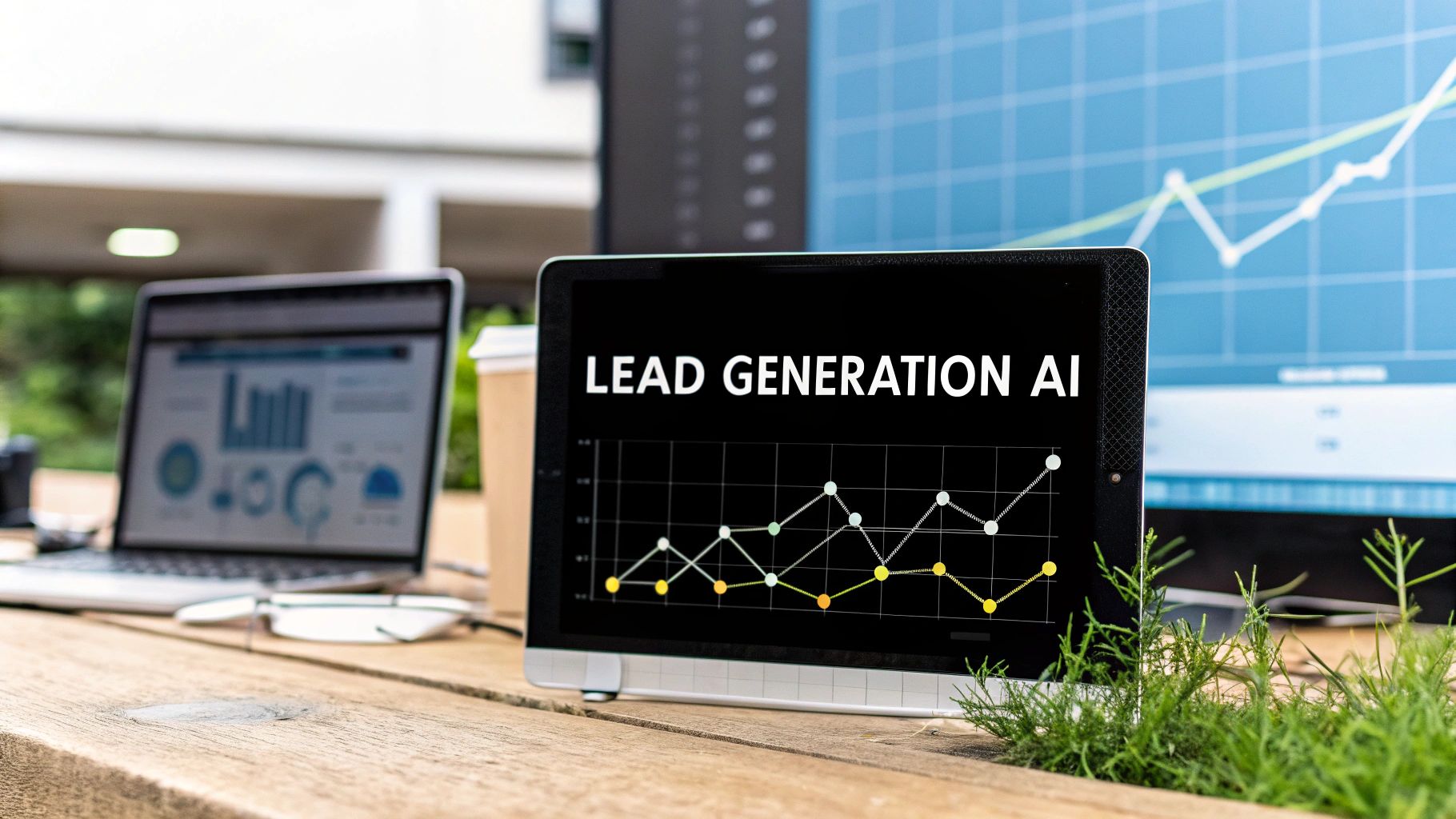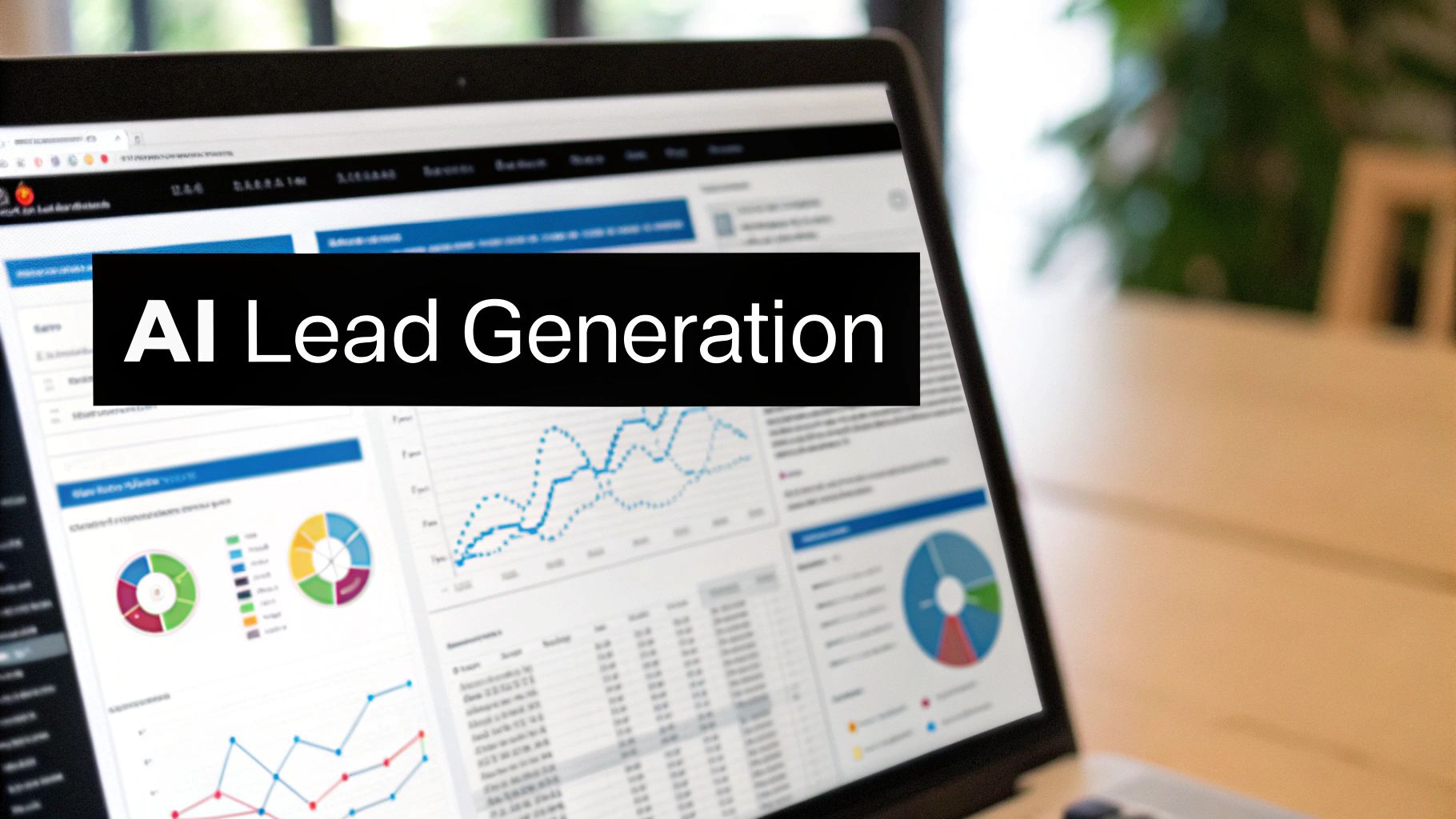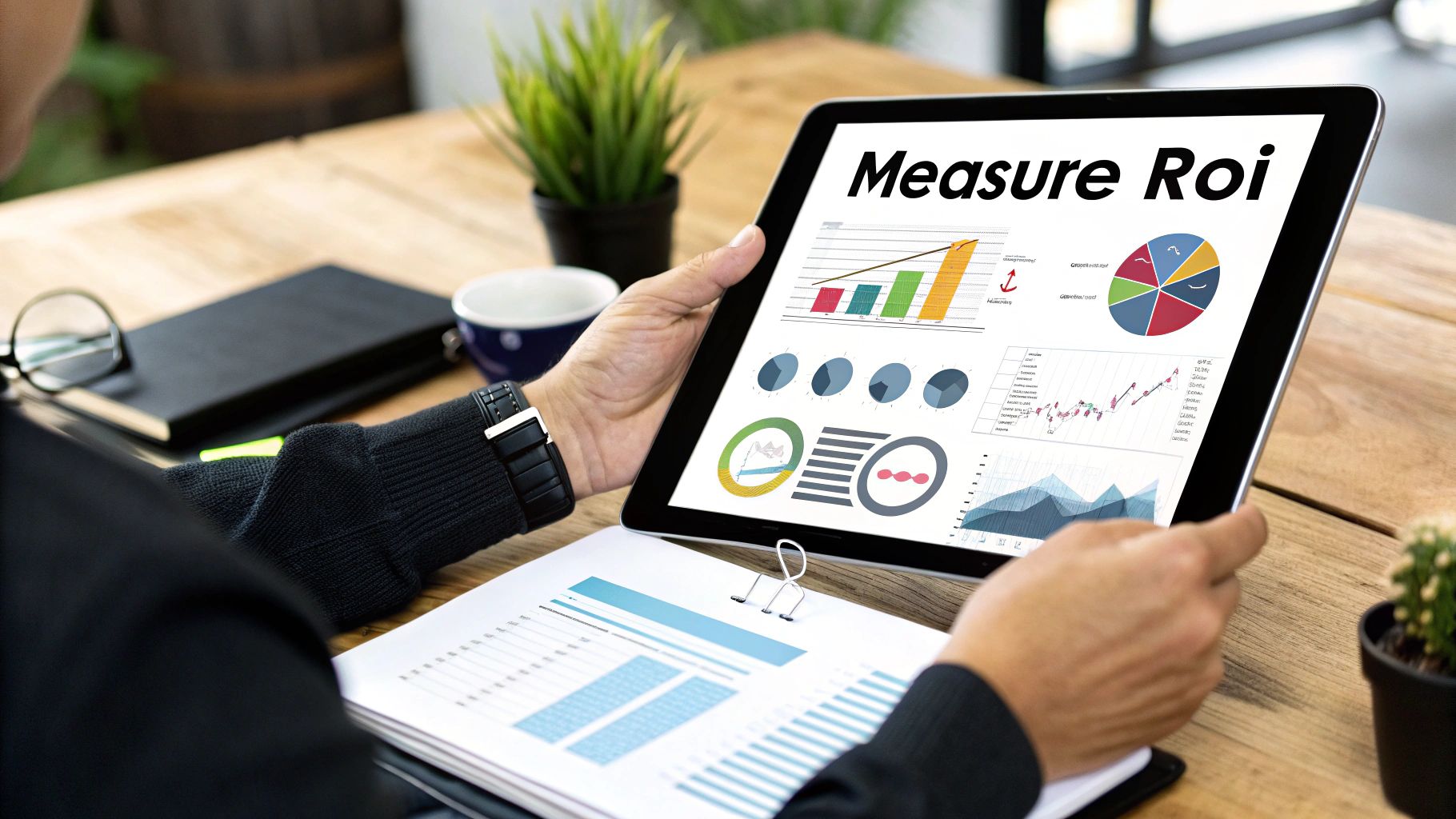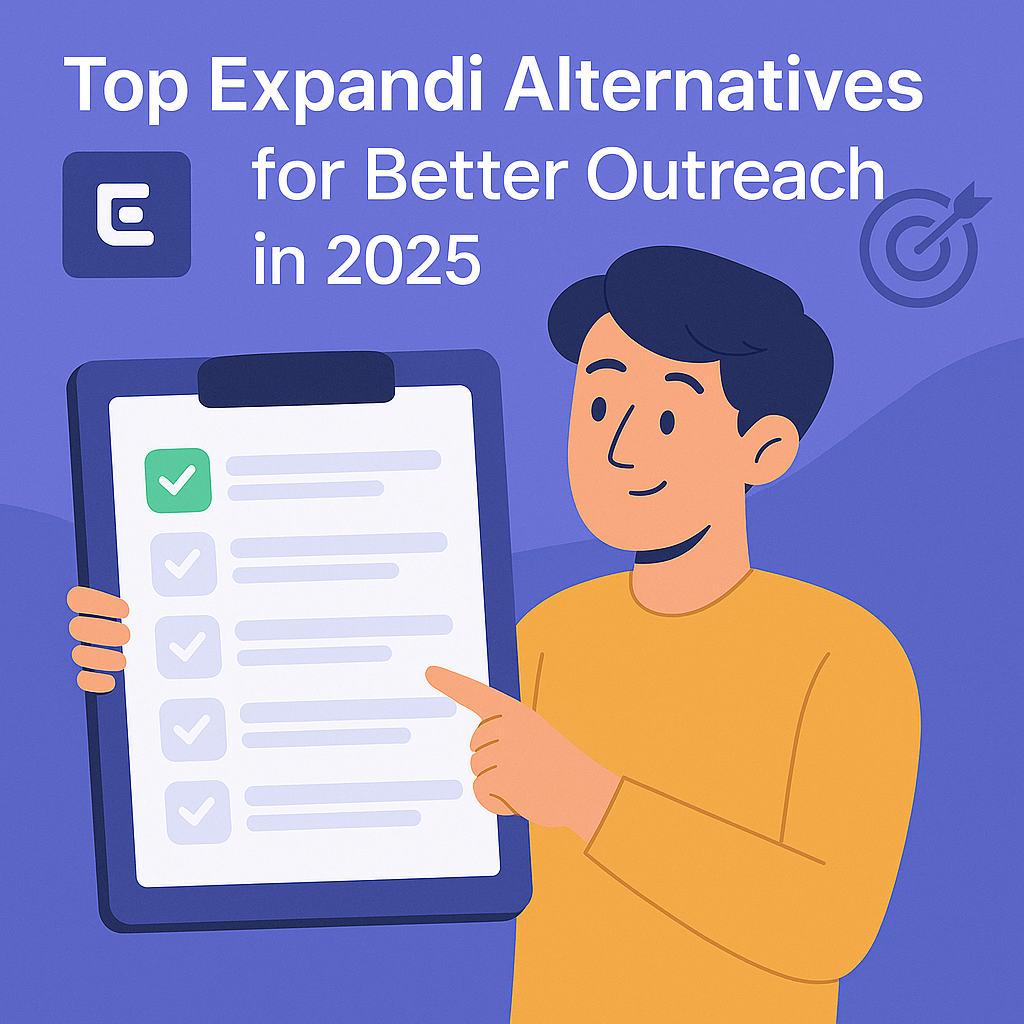Unlocking Growth with Lead Generation AI : The Ultimate Guide

Ever feel like your sales team is stuck in a hamster wheel, chasing down leads that go absolutely nowhere? I know how it feels because I've been there. You spend all this time and money, and for what? A pile of dead ends.
You can turn around such a situation using lead generation AI, and trust me, it's a game-changer. It’s all about using smart tech to automatically find, qualify, and warm up potential customers, so you can finally break that cycle of manual grunt work.
Let's dive deeper into how AI transforms the most frustrating parts of your job into an intelligent, automated system.
Moving Beyond the Grind of Manual Prospecting

For years, my team was burning through our budget on prospecting that delivered next to nothing. Our biggest mistake? We treated every potential lead the same, running on gut feelings and outdated contact lists. This wasn't just inefficient; it was demoralizing for the entire team.
Then, we introduced our first lead generation AI tool, and everything changed. This isn't just another buzzword; it’s a completely different way of finding your future customers.
What AI Really Changes
Forget the complicated jargon for a second. Think of AI as your most productive team member, one that works 24/7 to sift through the noise and find golden opportunities. The shift is massive. It takes your team from guesswork to data-backed precision.
And this isn't some niche trend; it's a huge economic driver. Let's take a quick look at a comparison to see what this means for your daily workflow.
Traditional Lead Gen vs AI-Powered Lead Gen
The difference is night and day. AI doesn't just speed things up; it completely reimagines the quality and intelligence of the entire process.
The biggest lesson I learned was that AI doesn't replace great salespeople, it makes them superhuman. It handles the robotic tasks, freeing them up to build genuine relationships.
While your team is manually scrolling through social media, your competitors are using AI for lead generation to boost sales. Can you really afford to fall behind?
How AI Identifies Your Best Customers

So, how does this AI "magic" actually work under the hood? It’s a lot more methodical than you might think. Every solid lead generation AI performs three core functions: identifying, scoring, and engaging your future customers.
Your AI is your own personal army of digital researchers. They never sleep, they never get tired; they're constantly scanning the web for clues that a company is preparing to make a purchase. Here's how they do it:
Job 1: Identifying Buying Signals
The first step is about identifying prospects who are already revealing their intentions. A smart AI goes way beyond static data, such as company size or industry; it actively hunts for dynamic buying signals.
What does that look like in the real world?
- Hiring Trends: A company posts job openings for roles that need a tool like yours. For instance, if you sell marketing automation software, a new listing for a "Marketing Operations Manager" is a massive green flag. 🟢
- Competitor Engagement: You notice key executives at a target account suddenly start following your main competitor on LinkedIn or liking their content.
- Funding Announcements: A startup in your ideal market just closed a Series A round. They now have fresh capital and an urgent need to scale; the perfect time for a conversation.
- Tech Stack Changes: The AI detects that a company just dropped one of your competitors’ tools from its website. What an opening!
These signals are popping up all the time, but they're nearly impossible for a human to track at scale. The AI sifts through this ocean of data to find the hidden gems.
Job 2: Mastering Predictive Lead Scoring
This is where I missed it early on. I used to rely entirely on gut feelings and a clumsy spreadsheet to decide who to call next. It was a disaster. I’d spend weeks chasing a "hot" lead that was never going to close, while a perfect-fit customer slipped right through the cracks. Sound familiar?
AI completely removes that guesswork. It analyzes dozens of data points simultaneously to assign a simple numerical score to each lead, guiding your sales team on where to focus their energy.
AI lead scoring isn't about complexity; it's about clarity. It turns a chaotic list of names into an ordered, actionable priority list, telling you, 'Start here. This one's ready.'
The AI examines everything: their website behavior (such as visiting your pricing page multiple times a day), firmographics (including company size, location, and revenue), and technographics (the software they currently use). The result is a system that gets smarter over time, learning from your closed-won and closed-lost deals to constantly refine its predictions.
Job 3: Engaging Leads Instantly and Intelligently
Once a high-value lead is identified and scored, speed is everything. A lead is 10 times less likely to convert if you wait more than five minutes to respond. This is where AI-powered engagement tools like chatbots and personalized email assistants become your secret weapon.
Instead of a generic "Thanks for your interest," an AI chatbot can qualify a visitor in real-time, book a meeting directly on a sales rep's calendar, and handle all the basic questions. AI can even draft hyper-personalized email opening lines.
This isn’t about replacing your sales team; it's about empowering them. The AI handles the initial, repetitive interactions, warming up leads until they're primed for a real, strategic conversation. This frees up your team to focus their valuable time on discussions that actually drive revenue. No more time wasted on tire-kickers. 😉
A Practical Guide to Implementing AI in Your Workflow
Ready to actually bring lead generation AI into your daily grind? Oftentimes, I see people diving in without a plan, hoping the tech will magically solve everything. Spoiler alert: it won't. This is your step-by-step playbook to making it work for you.
Step 1: Sharpen Your Ideal Customer Profile (Don't Skip This!)
This is the most critical, non-negotiable first step. Early on, I fed our new AI tool a vague description like "tech companies in North America." The result? A flood of completely irrelevant leads, from one-person IT shops to giant hardware manufacturers. It was a mess.
Garbage in, garbage out. Your AI is only as smart as the instructions you give it.
You need to get painfully specific. Go beyond industry and employee count. Think about the signals that really matter: technographics, hiring intent, and growth signals.
Get this right, and you’re giving your AI a treasure map. Get it wrong, and you're sending it on a wild goose chase.
Step 2: Choose the Right Tools for the Job
The market is flooded with AI tools, making it easy to become overwhelmed. You don’t need the most expensive or complex platform. You need the one that solves your biggest bottleneck at the moment.
Are you struggling with finding leads? Look at a tool that focuses on intent data. Is your problem qualifying website visitors? A conversational AI might be your best bet. Don't buy an all-in-one suite if you only need a hammer.
Pro Tip: Look for tools with native integrations to your existing CRM. This will save you a world of pain in the next step. My team once chose a "powerful" new tool that required a third-party connector to sync with our CRM. That connector broke constantly, and I lost a full week troubleshooting data sync issues. Never again.
Step 3: Integrate and Automate Your Tech Stack
This is where the magic happens, or where everything falls apart. Your goal is a seamless flow of data. When your AI identifies a high-intent lead, it should automatically appear in your CRM, be assigned to a sales rep, and be added to an outreach sequence. No manual data entry. 🙅♂️
Start simple. Your first integration should be a one-way push from your AI tool to your CRM.
- Authenticate Your Accounts: Connect your AI platform and CRM using your admin credentials.
- Map Your Data Fields: Tell the system which AI data point corresponds to which CRM field (e.g., "Company Name" in the AI tool maps to "Account Name" in CRM). Be meticulous here!
- Set Your Trigger: Define what action pushes the data. For example, "When a lead's score exceeds 85, create a new Contact in the CRM."
Step 4: Launch and Measure a Pilot Campaign
Don't boil the ocean. Begin with a small, controlled pilot campaign to demonstrate its effectiveness before rolling it out to the entire team.
- Define a Clear Goal: Aim for something specific, like "Generate 20 sales-qualified opportunities in 30 days."
- Identify Key Metrics: Track more than just lead volume. Monitor conversion rates from lead to meeting, and from meeting to opportunity. This indicates whether the AI is delivering quality.
- Run It for 4-6 Weeks: Give the system enough time to gather data and learn. You won't see meaningful results in a week.
Follow these steps, and you'll have a powerful, automated engine driving your pipeline. You'll build a smarter, more predictable path to growth, rather than just hoping for the best.
Lessons from the Trenches: AI Wins and Epic Fails

I’ve seen lead generation AI produce some incredible wins, but I’ve also made some face-palm-worthy mistakes that cost us serious time and money.
My goal here is simple: learn from my wins and my screw-ups so you can skip right to the good part. After all, anyone can tell you what you should do. The most valuable lessons, however, often come from dissecting what went horribly wrong. 😬
The Big Win: A Predictive AI Success Story
One of our first breakthroughs came from a B2B SaaS client who was struggling to convert trial users. They had thousands of sign-ups flooding in every month, but their sales team was completely drowning, trying to guess who to call first.
Every trial user was treated the same, which meant they were often slow to contact high-potential leads.
We introduced a predictive AI model. We fed it a vast amount of historical data on every user who had ever converted into a paying customer, including their industry, company size, the features they used most frequently, and how often they logged in, among other details.
The AI quickly started to spot the subtle patterns of a future champion user. Within just two weeks, it was scoring every new trial in real-time and flagging the top 15% as "high-fit" and ready for a sales call.
The results were stunning.
- The sales team stopped wasting time chasing ghosts.
- They focused their energy exclusively on the AI-qualified leads.
- In just one quarter, they boosted their trial-to-paid conversion rate by 40%.
It was a total game-changer. This proved that AI wasn’t just about finding more leads; it was about finding the right leads at the perfect moment.
The lesson here is powerful: Don't just use AI to find new prospects. Use it to find the hidden revenue already sitting in your funnels. Your best future customers might already be talking to you.
The Costly Mistake: Trusting AI on Autopilot
Now for the cringey part. Flushed with success, we got a little arrogant with our next project. We were launching an outreach campaign for a new cybersecurity product and decided to let the AI handle the entire process with minimal oversight. We defined our Ideal Customer Profile, synced the CRM, and hit "go."
For the first week, everything looked fantastic. The AI was cranking out hundreds of leads. But then a sales rep flagged something odd: "Hey, why are we targeting so many marketing agencies?"
My stomach dropped. We dug into the data and realized the AI had misinterpreted a keyword in our ICP. It latched onto the phrase "brand protection" and started pulling in marketing firms that offered brand reputation services, completely missing the cybersecurity context.
We had torched a significant chunk of our ad spend and outreach budget targeting the wrong industry entirely. It was an expensive and deeply embarrassing lesson.
What to Do vs. What to NEVER Do
So, what are the real takeaways from these stories? It all boils down to this: AI is an incredibly powerful copilot, but you are still the pilot. Never, ever hand over the controls completely.
What to Absolutely Do ✅
- Start with a Focused Pilot: Select one specific problem to solve, such as our trial conversion issue. Prove the ROI on a small scale before you try to automate the entire department.
- Audit Your AI's Decisions Weekly: Set a recurring calendar reminder to review the leads your AI is generating. Are they actually a good fit? A 15-minute check-in can save you thousands.
- Feed It High-Quality Data: The predictive model worked effectively because we provided it with clean, historical conversion data. The outreach campaign failed because our initial inputs were ambiguous.
What to NEVER Do ❌
- Set It and Forget It: This is the cardinal sin of using lead generation AI. An AI on autopilot with no human supervision is a recipe for disaster.
- Use Vague Inputs: Don't tell your AI to find "tech companies." Tell it to find "B2B SaaS companies with 50-200 employees that just hired a VP of Sales." Specificity is everything.
- Ignore Human Feedback: Your sales team is your first line of defense. If they tell you the lead quality is dropping, listen to them immediately. They are your human-in-the-loop reality check.
My mistakes taught me that the best approach is a human-AI partnership. Let the AI do the heavy lifting of data analysis and pattern recognition while you provide the strategic direction and critical oversight. That's how you unlock sustainable growth without driving your strategy off a cliff.
Choosing the Right Lead Generation AI Tools
Navigating the crowded market of lead generation AI tools can feel like walking through a funhouse; it’s disorienting, and every shiny new object is designed to distract you. My goal here is to help you cut through that noise and build a tech stack that drives results.
I once made the classic mistake of buying into the "all-in-one" dream. We invested in a massive, expensive platform that promised the world. The reality? We used only about 20% of its features, and it was so clunky that our team avoided it. It was a powerful tool, but it wasn't the right tool for us.
Breaking Down Your Options
To simplify this, let's categorize these tools into three main buckets. Each one serves a different, vital purpose in your lead generation process.
- All-in-One Platforms (The Command Center): These tools, like HubSpot AI, aim to be the central hub for your marketing, sales, and service efforts. They integrate CRM functionality with AI-powered features, including lead scoring, chatbots, and email automation. They are ideal for teams that need a single source of truth for all customer data.
- Specialized Lead Scoring Tools (The Brain): Platforms like MadKudu excel at analyzing data to predict which leads are most likely to convert into buyers. They plug right into your existing CRM to add a powerful layer of intelligence. This is for companies with high lead volume that need to prioritize their sales team's focus.
- Conversational AI (The Greeter): Think of tools like Drift. Their primary role is to engage website visitors in real-time, ask the right questions to qualify them, and schedule meetings for your sales team 24/7. They are best for businesses with significant website traffic that want to convert more visitors into meetings.
The explosive growth of the AI market is what's making all of this possible. Businesses investing in AI for sales and marketing are experiencing revenue increases of between 3% and 15%. The trend is clear: integrating the right AI is essential for making lead generation more efficient.
Your Next Steps to Smarter Growth
We've covered a ton of ground, from the nuts and bolts of how AI works to my own hard-won lessons from the trenches. So, what's next? Most people get so paralyzed by analysis that they end up doing nothing. Don't be like most people.
Getting started doesn't require a massive budget or a degree in data science. The best path forward is a straightforward, repeatable process, as outlined earlier.
This is your opportunity to transform your sales pipeline from an unpredictable trickle into a steady, predictable stream of high-quality leads. Your future customers are out there right now, looking for exactly what you offer. Your lead generation AI is the bridge that connects you to them.
Ready to start building that bridge? ✨ Your journey to smarter growth begins with that first small, decisive step.
Frequently Asked Questions
Will AI replace my sales team?
Not a chance. This is probably the biggest myth I hear, and I'm always happy to bust it. AI is a powerful assistant for your sales team, not a replacement. It excels at the repetitive, top-of-funnel manual work. This frees up your human reps to focus on their core duties. AI hands them better-qualified leads, which makes them far more efficient, not obsolete.
How can I get my team on board with using AI?
Great question. The key is to frame it as a tool that eliminates their most annoying tasks, not one that tracks their every move. Start with a small pilot group of your most tech-savvy reps. Show them how the AI can reduce their research time and serve up hot leads, allowing them to spend more time selling (and earning commission).
Once they become internal champions and start seeing results, their success will be the best marketing you can do to get the rest of the team excited. Focus on the "what's in it for me" for the reps, and adoption will follow.
Is lead generation AI difficult to manage?
It really depends on the tool, but the good news is that the industry is leaning heavily into user-friendly, no-code interfaces. Most modern AI platforms are designed for marketers and salespeople. You’ll often find intuitive drag-and-drop builders and simple, one-click integrations with your CRM.
The initial setup might take a few hours to connect your accounts and set your rules, but after that, day-to-day management is often just a matter of checking a dashboard once a week to see how things are performing. It’s far less intimidating than it sounds. 😉
Ready to stop the manual grind and start generating a pipeline on autopilot? GojiberryAI is your AI copilot for finding high-intent B2B leads and automating your outreach. Start finding warm leads today!
More High-Intent Leads = Your New Growth Engine.
Start Now and Get New High Intent Leads DeliveredStraight to Slack or Your Inbox.







.png)

.png)
